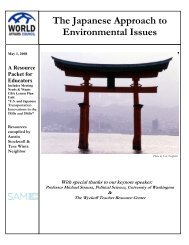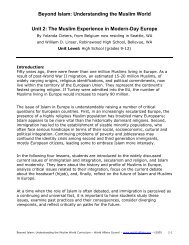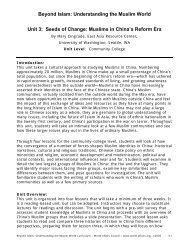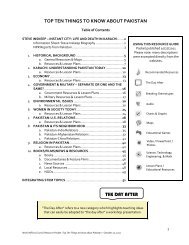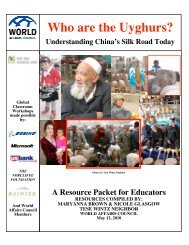The Question(s) of Tibet - World Affairs Council
The Question(s) of Tibet - World Affairs Council
The Question(s) of Tibet - World Affairs Council
Create successful ePaper yourself
Turn your PDF publications into a flip-book with our unique Google optimized e-Paper software.
ENVIRONMENTAL ISSUES<br />
surpassed the value <strong>of</strong> the industry and mining sector in 2004. Most county agencies have<br />
established a permit system and require collectors to obtain licenses. <strong>The</strong> ever‐growing<br />
economic importance <strong>of</strong> these fungi raises concerns regarding sustainability <strong>of</strong> current harvest<br />
levels. <strong>The</strong>re are scientific studies regarding matsutake that conclude that when using<br />
appropriate harvesting techniques sustainability should be guaranteed.<br />
Economic Development and its Impact on the Environment <strong>of</strong> <strong>Tibet</strong><br />
GLOBALIZATION TO TIBET<br />
http://www.tibetjustice.org/reports/enviro/globalization.pdf<br />
This paper examines the impact globalization has had on <strong>Tibet</strong>, includes the environmental<br />
ramifications in <strong>Tibet</strong> and throughout the Himalayas.<br />
HUMAN RIGHTS AND THE LONG TERM VIABILITY OF TIBET’S ECONOMY (1997)<br />
http://www.tibetjustice.org/reports/enviro/apec_paper.html<br />
Mining and logging have been particularly destructive to the <strong>Tibet</strong>an environment. Few<br />
safeguards have been imposed on strip mining operations with the result that lakes, rivers,<br />
groundwater and soil have been contaminated. Logging has caused soil erosion that threatens<br />
major river systems, threatens the long‐term arability <strong>of</strong> the land, and may even be<br />
contributing to climate change….<br />
LHASA MAPS<br />
http://www.asianart.com/lhasa_restoration/map.html<br />
<strong>The</strong> Lhasa Archive Project has recently produced a multi part map <strong>of</strong> the historic changes which<br />
have occurred in Lhasa from 1948 to the present day. <strong>The</strong> images included show small versions<br />
<strong>of</strong> the first series <strong>of</strong> maps, where the total urban area <strong>of</strong> the Lhasa valley is shown in blue in<br />
1948, 1980 and 1998. This clearly shows the extraordinary growth which has taken place over<br />
the past 50 years.<br />
TIBET’S ENVIRONMENT WELL PRESERVED THROUGH SUSTAINABLE DEVELOPMENT<br />
(3/31/09)<br />
http://www.china‐embassy.org/eng/gyzg/t555211.htm<br />
While other sources would disagree strongly with the Chinese government’s assessment <strong>of</strong> the<br />
environment in the <strong>Tibet</strong> region, this source provides an interesting perspective from research<br />
provided by the Chinese government. <strong>Tibet</strong>'s environment has been well preserved in its<br />
economic development and modernization, said a report published Monday by the Beijingbased<br />
China <strong>Tibet</strong>ology Research Center. "In China, <strong>Tibet</strong> is the place nearest to the sky and<br />
furthest away from pollution," read the Report on the Economic and Social Development <strong>of</strong><br />
<strong>Tibet</strong>. In 2007, more than 98 percent <strong>of</strong> the days in Lhasa registered with "excellent" or "good"<br />
air quality, with only seven days registered as "slightly polluted."<br />
<strong>The</strong> human afforested area in the region jumped from 868 hectares in 1990 hectares to 19,069<br />
in 2007, including 13,132 hectares <strong>of</strong> shelter forests which plays an important role in ecological<br />
protection, the report said. In addition, the biodiversity in <strong>Tibet</strong> was well protected, it said.<br />
"Since the peaceful liberation <strong>of</strong> <strong>Tibet</strong> in 1951, not one species in <strong>Tibet</strong> has been found to have<br />
suffered extinction." <strong>Tibet</strong> also boasted 20 nature reserves, including nine at the national level<br />
and 11 at the regional level, with a total area <strong>of</strong> 41.26 million hectares, or 34.8 percent <strong>of</strong> the<br />
land area <strong>of</strong> <strong>Tibet</strong>.<br />
<strong>World</strong> <strong>Affairs</strong> <strong>Council</strong> Teacher Resource Packet – <strong>The</strong> <strong>Question</strong>(s) <strong>of</strong> <strong>Tibet</strong> February 28, 2011<br />
26



